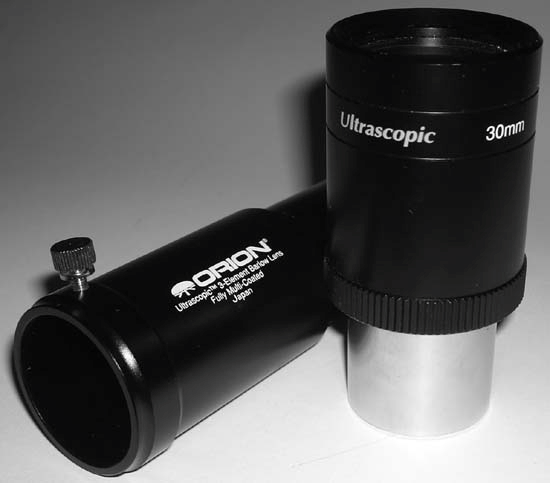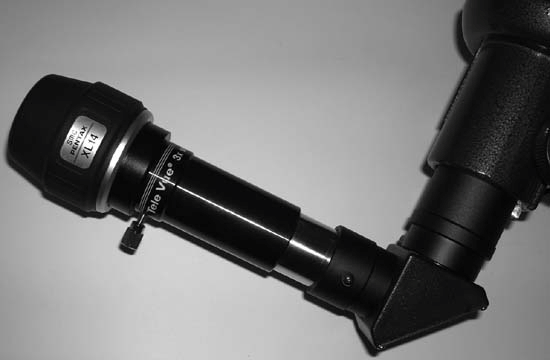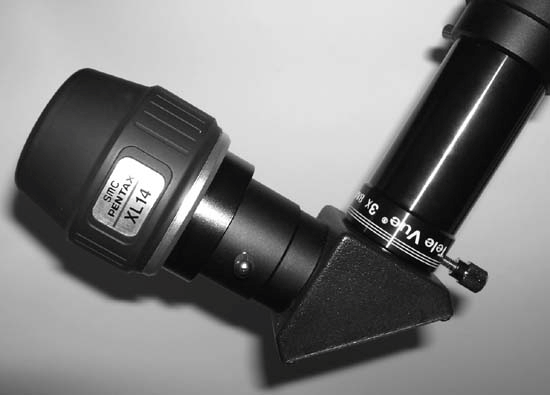Hack47.Determine Actual Barlow Magnification
Hack 47. Determine Actual Barlow Magnification
Find out why 3X doesn't always mean 3X. A Barlow [Hack #46], named for the English optician Peter Barlow (17761862), is a lens of negative focal length that astronomers use to increase the magnification provided by a telescope and eyepiece. In effect, a Barlow serves as an image amplifier. The Barlow is inserted into the focuser, and the eyepiece is inserted into the Barlow. Barlows are made in 1.25" models, which accept any eyepiece with a 1.25" barrel, and in 2" models, which which accept both 2" eyepieces and, with an adapter, 1.25" eyepieces as well. Because one Barlow can be used with any number of eyepieces, Barlows are very popular among amateur astronomers as an inexpensive means to multiply their range of available eyepiece focal lengths. Figure 4-5 shows a typical 1.25" Barlow; this one is an Orion Ultra-scopic 2X model, with an Orion Ultrascopic 30mm eyepiece. A Barlow functions by effectively increasing the focal length of the telescope, and thereby its magnification with any given eyepiece. For example, if you use the Ultrascopic 30mm eyepiece in a telescope of 1,200mm focal length, the combination provides 40X magnification (1,200/30=40). If you insert the Tele Vue 3X Barlow between the eyepiece and focuser, it has the effect of increasing the focal length of the scope from 1,200mm to 3,600mm, and thereby the magnification from 40X to 120X. Figure 4-5. An Orion Ultrascopic 2X Barlow with an Orion Ultrascopic 30mm eyepiece
So far, so good. The problem is that Barlows don't actually have a fixed magnification, despite the fact that they're clearly labeled as such. The actual magnification provided by a particular Barlow depends on many factors, including the depth to which the Barlow is seated in the focuser, the depth to which the eyepiece is seated in the Barlow, the focal plane position of the eyepiece, the optical design of the eyepiece, and so on. A nominal "3X Barlow" may actually provide anything from 2.5X to 5X magnification or more, depending on how it is used. A 3X Barlow may in fact provide 3X amplification, for example, when used between the diagonal of a refractor and the eyepiece, as shown in Figure 4-6. But if you insert that same Barlow between the focuser of the refractor and the diagonal, as shown in Figure 4-7, it may provide 4.5X or 5X amplification because of the additional separation between the Barlow and eyepiece. Figure 4-6. A Barlow inserted between the diagonal and eyepiece provides near-nominal amplification Figure 4-7. A Barlow inserted between the focuser and diagonal provides greater amplification It's important to know the actual amplification factor of a Barlow because it affects the true magnification and field of view of any eyepiece it is used with. The only way to determine the actual amplification factor of a Barlow with a particular scope and eyepiece is to measure it. To do so, you need a meter stick or other accurate measuring device and a large, flat open area. (You can use a yard stick, but a meter stick makes calculations much easier.) Set up your scope with the eyepiece inserted but without the Barlow. Orient the scope horizontally. By trial and error, place the meter stick at a distance where, when it is sharply focused, the eyepiece field of view includes most, but not all, of the meter stick.
Record the total number of millimeters visible from one edge of the field to the other. Then insert the Barlow, refocus on the meter stick, and record the number of millimeters visible. Divide the first number by the second to determine the actual amplification factor of the Barlow when used with that scope and eyepiece. When we tested, 95.8 cm (958mm) was visible on the meter stick with the eyepiece alone. With the Barlow inserted, only 31.2 cm (312mm) was visible. The amplification factor of that Barlow, used with that scope and eyepiece at that distance is 958/312 or 3.07X. Repeat the process for each scope/eyepiece combination you plan to use with your Barlow.
Alternatively, you can calculate the actual amplification factor of your Barlow by drift testing an eyepiece [Hack #57] with and without the Barlow in place. Divide the time required for the star to drift across the field without the Barlow in place by the time required with the Barlow in place to give the actual amplification factor of the Barlow. |
EAN: 2147483647
Pages: 112
